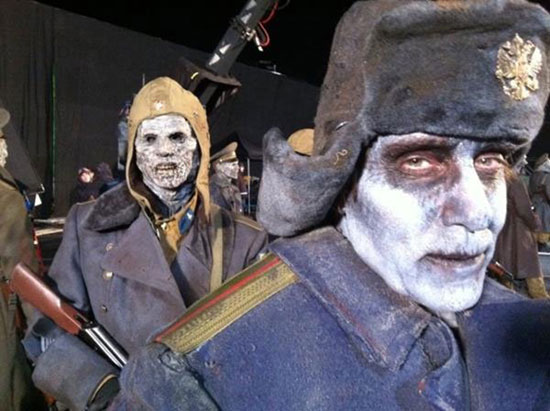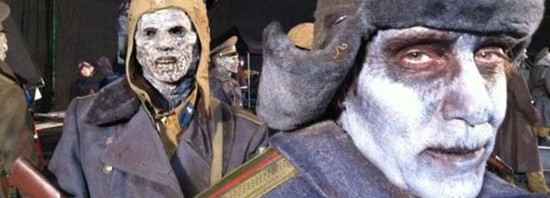from e-flux.com
The dramatic events in Russia and Ukraine over the past two years have begun a new phase in the struggle over the legacy of communism in the post-Soviet space. As the concrete features of “real socialism” become blurred and vanish, those necessary for the production of ideology become ever more sharply defined. It’s often argued that communism, buried a quarter of a century ago as living practice, has since acquired an afterlife in the form of a restlesscorpse, a remnant, a regurgitated survivor from the past, blighting the lives of new generations.
A popular explanation for the unfulfilled transition to market normality in Russia in the early 1990s involves the absence of a special act of “repentance,” after which the final nail in the coffin of communism would presumably have been driven in. This act, as far as one can tell, assumes that a single and all-encompassing purge of collective memory at all levels—from monuments and street names to individual consciousness—would be sufficient to exorcize the ghost forever. The enemy is understood to be dangerous precisely because it belongs more to the past than to the future. Its materiality is derivative and contingent. Of course, you can demolish every Lenin monument on Earth, but this doesn’t mean that communism has vanished once and for all. Besides, the fewer the external manifestations of this specter, the more powerful it becomes.
The Long Life of a Remnant
The theme of the inner slave, homo sovieticus, the “Red Man” who takes his leave but doesn’t actually go anywhere, has become a central theme in the work of the 2015 Nobel Laureate for literature, Svetlana Alexievich. In her Nobel Lecture, Alexievich stated: “The ‘Red Man’ wasn’t able to enter the kingdom of freedom he had dreamed of around his kitchen table. Russia was divvied up without him, and he was left with nothing. Humiliated and robbed. Aggressive and dangerous.”1
This post-Soviet man, in the final analysis, becomes a victim of himself, of his own unvanquished inner slavery, which explains his inability to assume and make use of his own freedom. Market reforms have altered the external conditions of his existence, providing new opportunities, but they have left his corrupted and crippled soul intact. The bitter legacy of this inner corruption has also defined the fate of the emerging generation that, taking advantage of the “inner freedom” of loans and growing rates of consumption, has given their consent to the authoritarian officials who provide them with this earthly bread. The Red Man, deprived of any material explanation, turns into a purely moral problem that refuses any hard and fast resolution, leading to its endless reproduction.
Such a dehistoricization of the Red Man turns him into a new myth, an eternal image, for which Alexievich predictably finds a correlate in the famous Grand Inquisitor section of Dostoyevsky’s The Brothers Karamazov.2 The Red Man is a natural phenomenon, but one that is false, derivative; it has replaced the authentic man, who is characterized by compassion, kindness, and the ability to live in the world with himself and with others. The clash of these two principles, the inner struggle that wracks anyone who finds themselves in an extreme situation (such as war or catastrophe), represents Alexievich’s main theme as a writer.
At the present moment, this struggle is far from over. The final battle still awaits us.
One cannot simply forget about the Red Man. It’s not possible to simply absorb him into the new reality. Alexievich is convinced that he will “disappear from the bloodstream” through a process of “suffering and overcoming,” and only then will we be able to reacquire our own selves and “finally … become like everyone else.”3
The famous Russian writer Vladimir Sorokin has an equally pessimistic outlook: “the post-Soviet man not only doesn’t wish to squeeze that Soviet pus out of himself but, on the contrary, recognizes it as fresh blood.”4 The Soviet “zombie” deprives us of the right to be contemporary. Instead, we are doomed to live amidst the putrid remains of the past. A return to normal historical time is not possible through a formal procedure of repentance, but requires something stronger—a chaotic upheaval or a purifying catastrophe. A forced return to normality, comparable to the process of de-Nazification in postwar Germany, would be a difficult but necessary reawakening, not unlike the one that follows “a high fever or an epileptic seizure.”5
The claim against today’s authorities in Russia comes down precisely to this conscious and criminal reluctance to bury the “Soviet corpse.”6 This reluctance is, crucially, not the product of those complex and muddled relationships of the present found in current military conflicts, economic crises, the breakup of the welfare state in Western Europe, or the rise of radical Islam in the Middle East. Instead, the Russian state, as a whole, with its interests, conflicts, divided society, and dependent economy, is declared to be the result of a collective madness and a historical deviation, which it is necessary to remedy with the aid of surgical intervention. The picture of the world acquires a distinctly Manichaean cast as it becomes simplified into a bloody struggle between the future and the past, in which the latter is inevitably doomed.
The trope of the “revived corpse” was itself revived after the Russian annexation of Crimea in 2014. Its predecessor can be found in the post-Soviet myth of homo sovieticus, a monster developed in the course of a grotesque experiment on human nature. This golem is contrasted with the more natural homo economicus, whose rationality is governed by the market and whose life is made viable through the political mechanism of liberal democracy.
In the sociology of Yuri Levada and his followers, the existence of homo sovieticus was established scientifically over the course of many studies. According to Levada, the defining features of “Soviet man” are “enforced self-isolation, state paternalism, egalitarian hierarchy, and a postimperial syndrome.” This “new man” was artificially developedat the beginning of the 1920s and is “characterized by individual irresponsibility, a tendency to shift the blame for his own situation onto anyone else: the government, parliamentarians, bureaucrats, Western countries, immigrants.” Changes in external conditions and, above all, in the socioeconomic bases of Soviet society, have not led to the restitution of human “normality”: “the destruction of former models has not been combined with any serious positive work on the understanding of the nature of Soviet society and Soviet man, the formulation of other guiding landmarks and social ideals.”7
The new society—capitalism—could not be built by noncapitalist man, and so an attempt to change the base of society directly was thwarted by the superstructure, as the remnants of the old way of existence became an obstacle to the new.

A statue of Lenin in Berlin is removed from its plinth to be demolished on Nov. 13, 1991. Photo: Sygma/Corbis/Regis Bossu.
To read the whole article, please, click here.

